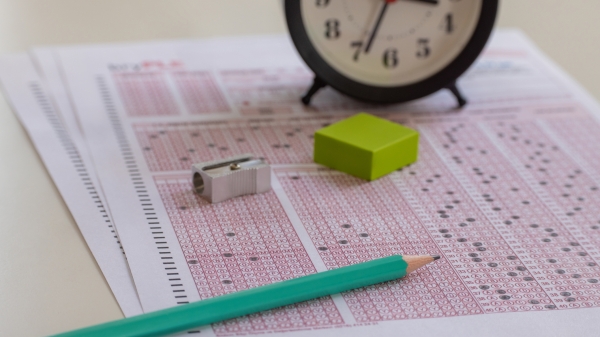Evolutionary biology graduate self-funded the dissertation research she’d always dreamed of doing

Nicole Coots' field work started on a self-funded trip to La Jolla, California, where she rented a kayak to collect radiolarians in the ocean.
Editor’s note: This story is part of a series of profiles of notable fall 2024 graduates.
Nicole Coots’ dissertation work started alone on a kayak she’d rented in La Jolla, California, filling plastic vials with ocean water while trying not to fall in.
The plan was to collect some samples, return the kayak, then immediately drive the seven hours back to Arizona to look at them under a microscope late into the night. This, she hoped, would be the start of her work studying radiolarians, which are single-celled marine eukaryotes that come in a dazzling array of shapes and sizes when you can get a glimpse of them under a microscope.
“They’re so freaking beautiful,” Coots said with a smile.
Coots fell in love with radiolarians as an undergraduate, and came to ASU planning to study them and their relationship with phytoplankton. Phytoplankton, which are microorganisms with the ability to photosynthesize, live inside radiolarians in a relationship called endosymbiosis that provides the radiolarian with extra nutrients.
After arriving at ASU, though, Coots realized the lab she’d join didn’t have any projects she could join in on to do that work. She hopped on a project studying symbiosis with a very different system: termites and protists that live in their guts, which digest the wood that termites eat. While the termite system was interesting enough, Coots was determined to study radiolarians like she planned.
“If there’s anything I learned in my PhD, it’s that I’m extremely stubborn.”
Coots found sources of funding on her own to do that work. First, there was a $500 award from the Graduate Student Professional Association that funded her rushed roadtrip to La Jolla.
“It was the most scrappy field work I’ve ever done,” she said, laughing. “But, hey, I got a paper out of it.”
Next, she was awarded a $4,000 fellowship to do radiolarian work in Okinawa, Japan –– exactly the work she’d been dreaming of. But then the COVID-19 pandemic hit, cancelling her internship.
“At that point I had no money, no plan and La Jolla was not sustainable for the projects I needed to do. So, I was about to quit. And then I got the Bermuda Institute of Ocean Sciences Grants-In-Aid award, which funded my fieldwork in Bermuda. That’s how I finished my PhD.”
Coots spent her time in Bermuda collecting samples of radiolarians at different depths, then isolating them and taking their pictures under microscopes, plus studying their DNA. The point, she explained, was to understand the diversity of the radiolarians that exist in Bermuda, as well as the phytoplankton that live within them and what environmental factors might make some relationships more likely to come about.
Coots was also awarded the Lisa Dent Memorial Ecology Fellowship and a Completion Fellowship from the School of Life Sciences to complete her research and finish her PhD.
Scientists did not start studying single-celled eukaryotes like radiolarians at a molecular level until the 1990s, when DNA sequencing technology became more readily available. That’s relatively recent, so the study of endosymbioses involving single-celled eukaryotes is even newer. So, while the research Coots does describing the diversity of those endosymbiotic relationships might seem basic, she’s one the first to even do that work.
“These systems, radiolarians and termites, are extremely understudied … This is fundamental information that we still don’t really know,” she said.
Thanks to her stubbornness, Coots will get to continue studying radiolarians as part of a post-doctoral research position at the University of British Columbia in Vancouver, Canada. There, she will get to start studying the evolution of relationships between radiolarians and phytoplankton, and dive deeper into microscopy techniques that allow her to look at and take pictures of the creatures she loves.
“It was really hard. But man, I’m really glad I made it work, because that’s what I actually cared about in my PhD.”
Question: What was your favorite spot on campus for studying, meeting friends, or just thinking about life?
Answer: I really liked working outside of the MU (Memorial Union). I worked there any day it was nice. I specifically like it because people come up to you and talk to you a lot, which is really cool.
Q: What’s the best piece of advice you’d give to those still in school?
A: Probably to figure out how to maintain a good work-life balance. There’s a lot to do, and so much of it is self-imposed. And so, if you can manage to set strict boundaries with your work such that when you’re working, you’re on, and you’re not like texting or scrolling. And then when you’re not working, you’re not even thinking about work. I feel like that is the only way I’ve been able to maintain, you know, good mental health during my PhD.
More Sun Devil community

Tested tips for taking exams
With May quickly approaching, many students are starting to prep for their most important tests of the year — final exams.Toni Miceli, the inaugural director of the bar exam success program at…

School of Transborder Studies celebrates 15th anniversary
During the summer before his freshman year at Arizona State University, Salvador Macias participated in the AGUILA Youth Leadership Institute, a college access organization designed to help young…

Barrett program unlocks study abroad for first-year honors students
Twenty first-year students from Barrett, The Honors College at Arizona State University are spending their second semester studying abroad in Rome, Italy.Traveling in a tight-knit honors community…



